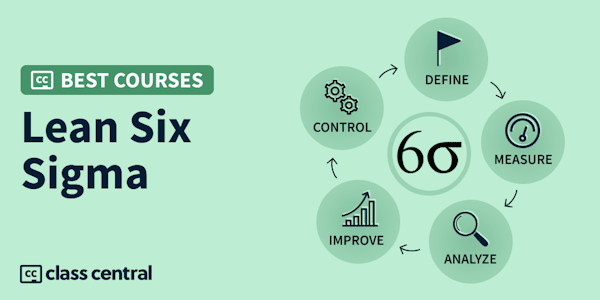Lean Six Sigma Green Belt is a course for professionals who are looking to deepen their understanding of process improvement by leading and facilitating the Lean Six Sigma projects in their departments.
Throughout this Green Belt course, you will learn the tools and concepts needed to lead Lean Six Sigma project teams using the DMAIC methodology. Completion of this course will indicate your competency in each of the methodology phases: Define, Measure, Analyze, Improve and Control, but more importantly you will understand how to implement, perform, interpret and apply Lean Six Sigma concepts. You will understand that in order to be successful as Lean Six Sigma Green Belt you will need the engagement and collaboration of your team and will be comfortable leading teams with diverse dynamics.
You will understand that facilitation of tools, such as root cause analysis or graphical analysis techniques, to push your problem-solving and process improvement ability further, and you will be comfortable facilitating these tools for your project team. You will also have an in-depth understanding of the Lean Six Sigma ideology and will be able to lead your organization’s culture of continuous improvement as well as support the organization’s leadership in prioritizing projects and solutions for the most impactful use of resources.
This course starts with a high-level review of key concepts from your Lean Six Sigma Yellow Belt course before moving focus to customer needs and requirements as a major input into the DMAIC project methodology. The course then progresses through the DMAIC methodology as you would facilitate your project, and spends significant time understanding the analyze phase for tools and techniques. This course also introduces Theory of Constraints and Statistical Process Control concepts that are not traditionally in Green Belt training, however are very complementary to either DMAIC projects or cyber-tech employees.
What is Six Sigma Green Belt?
Six Sigma is a group of tools and techniques that are designed to help companies improve production procedures and decrease the number of defects to safeguard quality. Attaining certification in Six Sigma, including the Green Belt level credential, demonstrates that candidates have the skillset needed to identify errors, risks, and defects in the production processes and to resolve them.
The Six Sigma series of certifications is divided into different levels. The levels, called belts, are white, yellow, green, black, and master black. At the green belt level, candidates must be able to demonstrate that they understand the concepts of Six Sigma and how and where it should be applied. Additionally, it shows they meet the following expectations:
- They operate with the support of or under the management of a Six Sigma Black Belt.
- They have the ability to analyze and solve quality issues.
- They are involved in projects to improve quality.
- They have participated in, but not yet led, quality projects.
- They have at least three years of relevant work experience.
- They have the ability to demonstrate knowledge of Six Sigma processes and tools.
What is Involved in this Six Sigma Green Belt Course Online?
Cybrary’s online Six Sigma Green Belt course online provides students with the knowledge, skills, and tools that are required to successfully pass the certification exam. The course will ensure that students have a thorough understanding of all the aspects of the Six Sigma method, including proficiency in all subject matters that are covered in the Define, Measure, Analyze, Improve and Control (DMAIC) phases that are outlined by the International Association For Six Sigma Certification (IASSC) Six Sigma Green Belt Body of Knowledge. Six Sigma Green Belts understand how to execute, perform, analyze, and apply Six Sigma with high levels of competency.
What Are the Benefits of Having a Six Sigma Green Belt Certification?
Having a thorough understanding of the Six Sigma methodologies, at any belt level, will positively affect a candidate’s career opportunities. Candidates who are able to include Six Sigma certifications on their resume demonstrate that they are committed to continued learning, improving their business expertise, and increasing their productivity and analytical abilities. These are all major attributes that hiring managers look for.
Additionally, earning the Six Sigma Green Belt certification will benefit candidates in the following ways:
- It demonstrates that an individual possesses the abilities needed to identify process problems and mitigate them.
- It allows individuals to increase and improve their knowledge of business processes.
- It shows that candidates have the abilities to improve the quality of deliverables and ensure customer satisfaction.
- It demonstrates that a candidate has a thorough understanding of DMIAC, which will help the organization improve its bottom line.
- It provides higher earning potential. Six Sigma certified professionals commonly earn over $100,000 annual salaries.
Hard is the Six Sigma Green Belt Exam?
The Six Sigma Green Belt certification exam is considered to be an intermediate level test. Some candidates will find it fairly difficult, while others will find it to be less challenging – especially those who have taken the time to prepare with a Green Belt training course. While it’s not a requirement, obtaining Six Sigma Green Belt training, like that Cybrary provides, prior to sitting the exam will improve a candidate’s performance on the test.
The Six Sigma certification exam consist of 100 questions, of which there approximately 20 from each section of the IASSC Six Sigma Body of Knowledge that pertain to the Green Belt. Candidates have three hours to complete the exam and must score at least 385 out of the possible 500 points to pass. The exam costs $295.
To enroll in Cybrary’s Six Sigma Green Belt course online and obtain all the knowledge you need to pass the certification exam, just click on the Register button in the top right corner of your screen.


